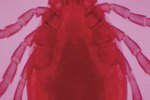
Chiggers are the immature larval form of mites. At only 1/150th to 1/120th of an inch in diameter, they are barely visible and able to move about virtually unseen. Chiggers inflict their microscopic bites on humans causing swelling, redness and itching. Chiggers are found in every U.S. state, but are most widespread and troublesome in the heat and humidity of the southern and midwestern regions.
Chigger 101
Chiggers -- and their parental units, mites -- are not insects. Close relatives of spiders and ticks, they belong to the class Arachnida and are members of a specific family of mites called Trombiculidae. They are predominantly parasitic. Trombiculids have four stages of development: egg, larva, nymph and adult. It's the mite's larval form -- the chigger -- that wreaks itchy havoc on humans.
Modus Operandi
According to the United States Army Public Health Command, chiggers are most active from spring to late autumn. In the warmest parts of the U.S., like Florida and southern Texas, they are active year-round. Female mites lay their eggs in vegetation, moist soil or leaf litter. Chiggers emerge from the eggs and congregate in shady, densely vegetated areas. They are attracted to human hosts when they sense the emanation of carbon dioxide. The chiggers climb aboard, slowly navigating toward areas with thin skin like the ankles, armpits or backs of the knees, or to areas where clothing fits snugly.
Moveable Feast
Once the chiggers have settled into a comfortable spot, it's time for them to begin feeding. They use sharp mouth parts to pierce the skin and release saliva with digestive enzymes that dissolves skin cells. They spend approximately three days feeding on liquified skin cells, at which point they drop to the ground, finish digesting their meal and morph into nymphs.
After the Ambush
According to Clemson University, chiggers do not transmit disease in the U.S. However, their bites can result in intense itching, redness and swelling that can last for weeks. If you suspect that you've walked into a chigger ambush, immediately take a hot bath with lots of thick soap lather to wash away the chiggers. Apply antiseptic to your bites. Ask your doctor or pharmacist about an antihistamine cream to relieve itching. Don't scratch your bites, as scratching can irritate the bite wounds and lead to secondary infections. Be sure to launder the clothes you were wearing in soapy, hot water to kill any remaining chiggers.
Chigger Myths
Although closely related to ticks, it's an urban myth that chiggers suck blood. Not the least bit vampiric, they are only interested in liquified skin cells. Another myth is that chiggers burrow into your skin. In truth, when affected skin becomes red and profoundly swollen, it may envelop the chigger, making it appear as if the chigger has embedded itself.
References
Resources
Photo Credits
-
PhotoObjects.net/PhotoObjects.net/Getty Images
Writer Bio
Yvette Sajem has been a professional writer since 1995. Her work includes greeting cards and two children's books. A lifelong animal advocate, she is active in animal rescue and transport, and is particularly partial to senior and special needs animals.



